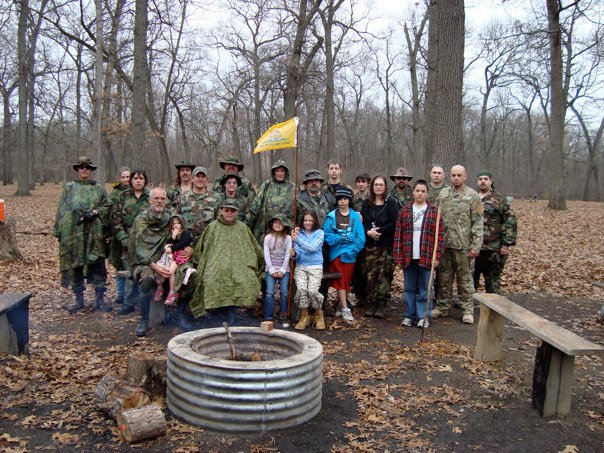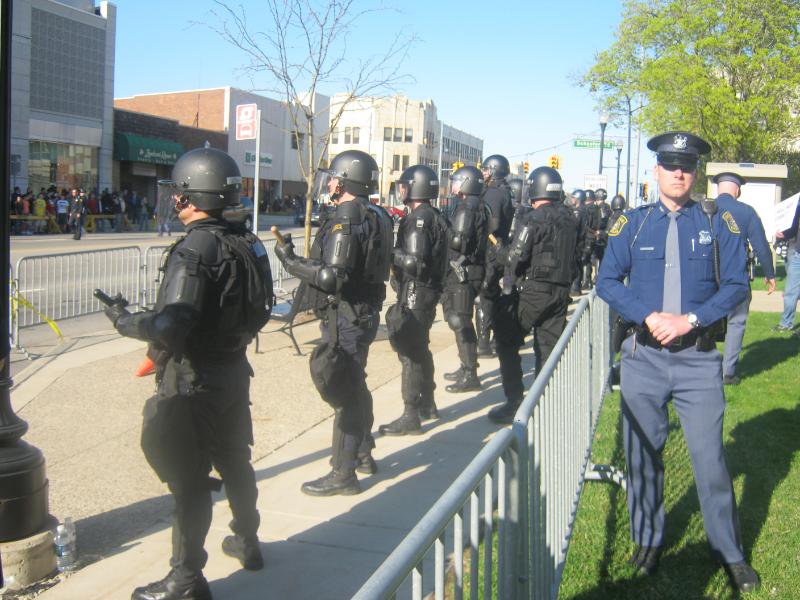RESEARCH
My research interests broadly concern how whiteness and masculinity are intersecting, lived experiences that shape people's attitudes about nationalism and racial politics in contemporary society. I use a social movement framework to understand how these topics then result in group action, including from anti-government and extremist groups.
My book Nostalgia, Nationalism, and the US Militia Movement (2024) is an accessible primer on the contemporary US militia movement. Exploring the complicated history of militias in the United States, starting with the Revolutionary War period, this book leverages unique data from ethnographic fieldwork, in-depth interviews, and previously unseen archival materials from militia founder Norm Olson to detail the modern movement’s origin and trajectory through the attempted insurrection of January 6th and beyond.This book uses the lenses of nostalgia and settler colonialism to explain militia members’ actions and beliefs, including their understandings of both nationalism and masculinity. This approach situates militias in a broader political landscape and explains how and why they will continue to be relevant actors in American politics.
A general audience will find this book approachable, and it will be of particular interest to people studying militias or other social movement organizations whose vision of an ideal nation rests on a nostalgic image of the past and potentially encourages political violence.
My book Nostalgia, Nationalism, and the US Militia Movement (2024) is an accessible primer on the contemporary US militia movement. Exploring the complicated history of militias in the United States, starting with the Revolutionary War period, this book leverages unique data from ethnographic fieldwork, in-depth interviews, and previously unseen archival materials from militia founder Norm Olson to detail the modern movement’s origin and trajectory through the attempted insurrection of January 6th and beyond.This book uses the lenses of nostalgia and settler colonialism to explain militia members’ actions and beliefs, including their understandings of both nationalism and masculinity. This approach situates militias in a broader political landscape and explains how and why they will continue to be relevant actors in American politics.
A general audience will find this book approachable, and it will be of particular interest to people studying militias or other social movement organizations whose vision of an ideal nation rests on a nostalgic image of the past and potentially encourages political violence.
Selected Public Sociology
Testimony to House Committee on Veteran's Affairs, Hearing on the Recruitment of Veterans by Domestic Violent Extremist Groups
Written commentary for the Veteran's Affairs Committee
“Inside America’s Militias.”
“Biden Wants to Unite the Country. How Can He Do It?”
“Armed groups from Capitol riot pose longer-term threat to Biden presidency.”
“As an expert on US militias, I know about the psychology of pro-Trump rioters. Biden should too.”
“Militia Expert Warns Trump’s Capitol Insurrectionists Could Try Again.”
“Lessons from embedding with the Michigan militia – 5 questions answered about the group allegedly plotting to kidnap a governor.”
“Militias’ warning of excessive federal power comes true – but where are they?”
“Militias evaluate beliefs, action as president threatens soldiers in the streets.”
Written commentary for the Veteran's Affairs Committee
“Inside America’s Militias.”
“Biden Wants to Unite the Country. How Can He Do It?”
“Armed groups from Capitol riot pose longer-term threat to Biden presidency.”
“As an expert on US militias, I know about the psychology of pro-Trump rioters. Biden should too.”
“Militia Expert Warns Trump’s Capitol Insurrectionists Could Try Again.”
“Lessons from embedding with the Michigan militia – 5 questions answered about the group allegedly plotting to kidnap a governor.”
“Militias’ warning of excessive federal power comes true – but where are they?”
“Militias evaluate beliefs, action as president threatens soldiers in the streets.”
Background: What are Militias and Who are Their Members?
|
In this section, I provide general information about militias. Specifically, I:
|
Militia Responses to Law Enforcement Intervention
|
Militia groups have a complicated relationship with law enforcement. On the one hand, many members are prior military and believe that both military and police are necessary to keep people safe. On the other, both the military and the police are agents of the government they perpetually worry is overstepping its bounds and infringing on individual liberties. Here, I discuss the skepticism that militias have toward law enforcement and explore how law enforcement interactions have the potential to push militia groups into a more extreme orientation.
|
Assessing Risk
Most militias and militia members are law-abiding citizens. However, some are not, and some law-abiding groups may sometimes share political or other overlap with other groups that are themselves prone to violence. One of the practical questions when investigating militias is thus: how do we determine which groups may be likely to shift to violent or otherwise dangerous action? There are many variables that factor into this assessment, but the Hutaree militia in Michigan, accused (and ultimately largely acquitted) of a variety of crimes, serves as a case study to offer some possible insights.
Militia Members' Responses to Other Groups
|
Militia Men and Issues of
Sex & Gender Sociological investigations of masculinity are often crucial for understanding any group that is predominately (or exclusively) made up of men. In this selection, I analyze the intersections of masculinity, nationalism, and whiteness that help us understand why some men feel compelled to join groups like militias.
However, I also show that these connections are not as rigid or stereotypical as often portrayed. I analyze how these men interact with each other, with their families, and--in one unique but instructive incident--with a transgender woman to better understand what masculinity means to these men. |
Militia Members' Views on Racialized Populations
Militia members are often described as racist and/or xenophobic. In this selection, I analyze the extent to which this is true, and whether racism alone is a sufficient explanation for some of the outgroup attitudes and behavior militia members direct toward the Black and immigrant populations in the United States.
I also analyze both how and why members' responses to both the idea of and the presence of Muslims in the United States is more exclusionary than their responses to other marginalized groups. A combination of racialization and nationalistic exclusion provides a fuller understanding of this scenario, and helps us understand how to better improve Muslim to non-Muslim intergroup relations in the United States. |
Methodological Issues When Studying Militias
|
Past Militia Research & Problems with Watchgroup Data
Many academic researchers and media sources alike use watchgroups like the Southern Poverty Law Center as their primary data source. Watchgroups do some excellent social justice work, but in this section, I explain why watchgroup data is methodologically problematic and leads to an incomplete understanding of militias. Instead, I strongly advocate for the need to use interviews, ethnography, and group-produced written materials as primary data sources to have a fuller and more nuanced interpretation of militias and similar groups.
|
Methodological Challenges of Studying Groups Like Militias
It can be challenging to study any group whose members are suspicious of outsiders. Here, I include some lessons from early in my fieldwork about how to navigate practical and ethical dilemmas with this specific population.
|
Academic Work on Non-Militia Groups
Neo Nazi Nationalism
In an effort to understand how supremacists may respond to future socio-political events, this article examines how White Aryan Resistance (WAR), as a major player in the White Supremacist Movement (WSM), conceptualizes nationalism and who qualifies as a ‘real’American. I use discourse analysis on two year’s worth of WAR newsletters: twelve monthly issues before the September 11, 2001 terrorist attacks and twelve issues after this date. Only partial support is found for outcomes that the existing nationalism literature would predict, suggesting that those who research the right-wing must better understand the WSM’s sense of status loss to adequately predict future violent action from these groups. I show that WAR did not increasingly target Arabs after the attacks, which may have enhanced their membership and mobilization efforts, but that this decision was a rational response in the context of status threats and limited movement resources.
In an effort to understand how supremacists may respond to future socio-political events, this article examines how White Aryan Resistance (WAR), as a major player in the White Supremacist Movement (WSM), conceptualizes nationalism and who qualifies as a ‘real’American. I use discourse analysis on two year’s worth of WAR newsletters: twelve monthly issues before the September 11, 2001 terrorist attacks and twelve issues after this date. Only partial support is found for outcomes that the existing nationalism literature would predict, suggesting that those who research the right-wing must better understand the WSM’s sense of status loss to adequately predict future violent action from these groups. I show that WAR did not increasingly target Arabs after the attacks, which may have enhanced their membership and mobilization efforts, but that this decision was a rational response in the context of status threats and limited movement resources.
Neo Nazi Normalization: The Skinhead Movement and Integration into Normative Structures
Skinheads, a subgroup of the larger Neo-Nazi Movement, traditionally presented themselves in a blatant, intimidating fashion replete with tattoos, Nazi symbology, and startling group imagery. Recently, however, the Skins have adopted a new tactic for recruitment: normalization. Members now strive to appear and behave more in accordance with mainstream societal standards in order to achieve perceived similarity with potential members. Using General Strain Theory to attribute the historical-sociological emergence of the Skinhead Movement to affirmative action, this article explores the phenomenon of normalization with a focus on the Skins’ evolving self-presentation, and describes a recent behavioral case example of the tactical change. Normalization is functionally explained in terms of frame alignment and frame resonance, while its effectiveness is demonstrated through Durkheim’s construct of mechanical solidarity.
Skinheads, a subgroup of the larger Neo-Nazi Movement, traditionally presented themselves in a blatant, intimidating fashion replete with tattoos, Nazi symbology, and startling group imagery. Recently, however, the Skins have adopted a new tactic for recruitment: normalization. Members now strive to appear and behave more in accordance with mainstream societal standards in order to achieve perceived similarity with potential members. Using General Strain Theory to attribute the historical-sociological emergence of the Skinhead Movement to affirmative action, this article explores the phenomenon of normalization with a focus on the Skins’ evolving self-presentation, and describes a recent behavioral case example of the tactical change. Normalization is functionally explained in terms of frame alignment and frame resonance, while its effectiveness is demonstrated through Durkheim’s construct of mechanical solidarity.
All work, including pictures, here and elsewhere on this website is protected by Copyright (© Amy Cooter, all rights reserved). You are welcome to cite my work with proper attribution.



